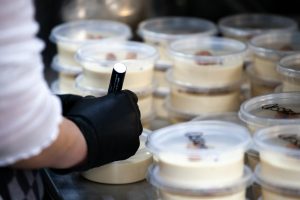5 Food Safety Mistakes You Might Be Making
Food safety should be the number one concern in any commercial kitchen. However, there are some common mistakes that establishments make that can put their customers at risk. Food borne illness can be devastating for a business and it can be difficult to recover your reputation. Avoid these mistakes by reviewing the information below and ensuring that your business follows correct food safety protocols.
-
Improper Hand Hygiene
Hand hygiene should be the foundation of food safety in your kitchen. It should also be engrained in the culture of your establishment that hand hygiene is of the utmost importance. Taking the time to properly train your staff to understand the risk of skipping (or rushing) hand hygiene and the benefits of taking the time to properly wash their hands. Hand washing should be done frequently and especially after handling raw meat, taking rubbish out, going to the bathroom etc.
It is also important that your handwashing facilities are stocked appropriately with appropriate soaps and hand towels. All cuts and wounds should be covered entirely with hospital grade bandages in a non-food colour (generally blue) to avoid contamination.
-
Improper Storage
Temperature
Food needs to be stored at their correct temperatures i.e. cold food kept cold and hot food kept hot. There should be systems in place to ensure that all food is kept at the correct temperature. Condenser coils in the coolroom that are clogged with dust, dirt and grime over time can make it difficult for your coolroom to remain at the correct, food-safe temperatures. This should be addressed in the regular cleaning of your premises and professional cleaners are generally required for areas that are difficult for staff to clean sufficiently.
Organisation
There are a few simple rules that should help your commercial kitchen keep your food organised in an appropriate and food safe manner:
- Food should be stored in appropriate containers that are labelled with cook dates and/or expiry dates.
- Raw food should be separated from cooked food and dry products need to stay dry.
- Meat needs to be stored below all other items to ensure that any drips do not contaminate other food, regardless of your faith in the integrity of the containers.
- Food should be utilised in a first in, first out basis.
- The golden rule is “When it doubt, throw it out” – it is better to lose money by disposing of ambiguous food than it is to have an outbreak of a foodborne illness.

-
Equipment
One of the most common sources of cross-contamination in a commercial kitchen is the cutting board. Old, cracked cutting boards provide areas for bacteria and germs to hide and breed. Cutting boards should be replaced regularly and colour coded to prevent cross contamination. Staff should be trained to use specific cutting boards for specific foods (i.e. meat, vegetables, bread etc.).
Knives can face a similar cross-contamination problem if used on meat and then vegetables for example. You need to ensure that your kitchen is well-stocked with enough high-quality knives that can be put out to be washed after being used on just one type of food. The same is true of things such as tongs, storage containers, scissors etc.

-
Working When Ill
Though it is the responsibility of your staff to recognise when they are sick and to not work around food, it is important to provide them with sufficient leave so that they do not feel that they have to continue to work when sick. Infectious disease can easily be spread through an infected member of staff entering the kitchen and handling food or utensils.
This again comes down to the culture that is cultivated in your establishment that ensures that employees are not punished for having time off due to illness.
-
Improper Cleaning and Sanitisation
It’s important that all areas in your commercial kitchen are sanitised on a regular basis. Many areas are able to be managed easily by in-house staff including kitchen benches, utensils, bins etc. Your kitchen needs to be fully equipped at all times to ensure that this sanitisation is easy for your staff to carry out. This includes sanitising chemicals and cleaning equipment such as clothes, mops, etc.
There will be areas in your kitchen that are difficult or time-consuming for your staff to clean and sanitise, such as coolrooms, internals of dishwashers, internals of ice machines etc. These areas can harbour harmful bacteria and mould and need to be regularly cleaned by professionals who know how to effectively clean this type of equipment. Not only are there food safety implications but unclean equipment can also increase energy consumption and put the equipment at increased risk of breakdown. There are many risks to your business if food safety standards are not adhered to.
Reach out to the trusted professionals in certified cleaning today.
Jaymak is the only ISO 9001 and ISO 22000 certified company for specialised cleaning services to the hospitality, healthcare, and food industries in Australia and New Zealand. Only trust the reputation of your business and livelihood with certified cleaners!
References:
5 Food Safety Mistakes You’re Making in Your Restaurant – Cenza (cenzasmart.com)
Cleanliness of Food Preparation Areas (foodsafetysolutions.com.au)
Kitchen Hygiene: The Complete Checklist – Lightspeed (lightspeedhq.com.au)
The Most Common Food Hygiene Mistakes People Make | HuffPost Health
5 Food Safety Mistakes You Don’t Want Your Kitchen Staff Making | FSR magazine
Food Safety Mistakes: What to Avoid and How | FHC Blog (foodhygienecompany.co.uk)
Comments are closed.

